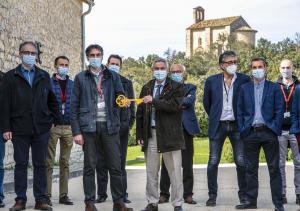A place to meet
Scientific cooperation is not about exchanging data, ideas and theories only. It builds on basic human dynamics, personal interactions, arguments, jokes, smiles and the whole spectrum of emotions that is common to the men and women of this world. When different groups working on the same experiment are separated by immense stretches of land and ocean, there is a need for a "meeting place"—even if it is partly a virtual one.
In late 2019, EUROfusion—the consortium of European fusion research institutes—began planning for a remote experiment centre where European scientists working on the Euro-Japanese JT-60SA satellite tokamak experiment would gather as a group to interact with their Japanese colleagues. "The idea was to bring people together in the same room rather than having them connect individually from their office. It was about re-creating an atmosphere," says Gerardo Giruzzi who led the preparation for the scientific participation of EUROfusion in the JT-60SA project.
Four months later, the COVID pandemic struck, imposing limitations on gatherings and travel. What had been a simple need to facilitate team cohesion and communication within the JT-60SA project now became a necessity for the broader worldwide fusion community.
The remote experiment centre now exists. It is located in a renovated building on the vast domain of Château de Cadarache, a few kilometres from the ITER site. On Friday 12 March, the French Alternative Energies and Atomic Energy Commission (CEA), which provided the building, handed over a symbolic key to the Institute for Magnetic Fusion Research (IRFM) which will operate it.
The 300 m² facility will comprise a large "participation room," along with meeting spaces that are fully equipped with giant screens and sophisticated communication tools. "The remote experiment centre originated from the needs of the JT-60SA teams," explains Frédéric Imbeaux, the head of the Fusion Plasma Physics Department at EUROfusion. "But we will be able to use it for collaborating with EAST and HL-2M in China, DIII-D in the United States, JET in the United Kingdom, and of course IRFM and ITER. We have also entered discussions with the Fusion Department at Aix-Marseille University. This tool can contribute to establishing the fusion community of tomorrow."


